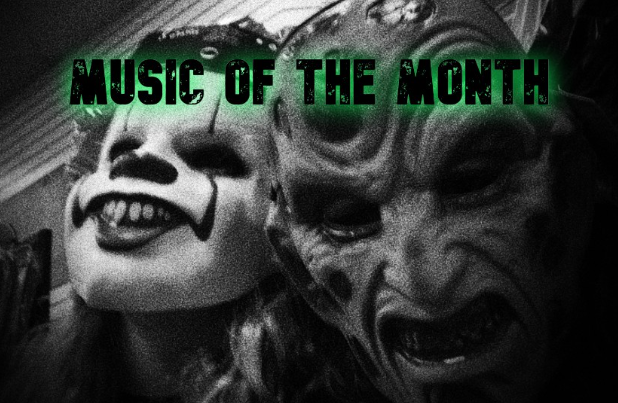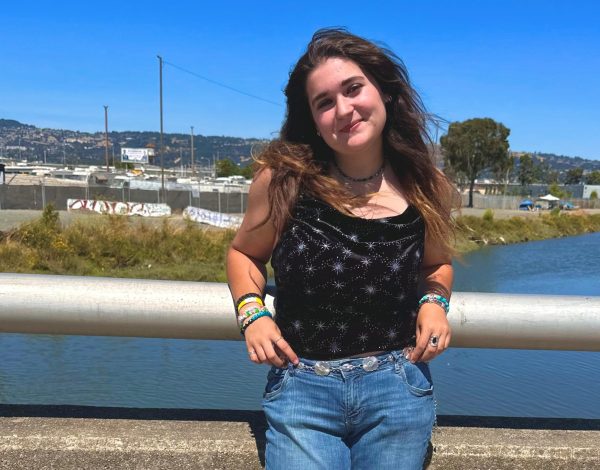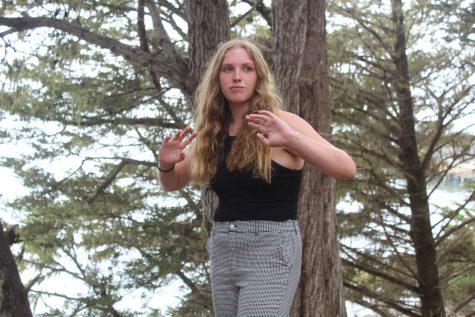Music of the Month: October
A look at our top Halloween songs for the month of October.
Cali and Brianna compile a list of their top songs each month and go in depth with them.
November 14, 2022
Happy October! In lieu of spooky season, we decided to write about some of our favorite tunes that are very Halloween-esque, instead of our typical model. We hope you enjoy it! Happy Halloween!
Cali’s Picks
“Nosferatu Man” by Slint, “Spiderland” (1991)

From the dark and murky depths of Louisville, Kentucky came Slint, a short-lived, genre-bending band that combined musical elements of goth rock, post-punk, and experimental math rock. “Nosferatu Man” is a track on their critically acclaimed second and final studio album, “Spiderland”, that brings an otherworldly and spine-chilling mood to the listener. The apt lyrics stay true to the title as McMahan narrates from the perspective of Dracula and what his vampirish life consists of. The song begins with a few snare hits and sour guitar chords that quickly transition into the hushed and pinch-harmonic filled verse. In the verses, vocalist Brian McMahan speaks each line in a lowly undertone that brings a haunting resonance over the listener as the prominent drums and hair raising guitar accompany him. The choruses channel feelings of wrath as the muted guitars become distorted and McMahan yells out each line, which greatly contrasts the softer verses. Following the second chorus, the band carries away into an instrumental bridge riddled with hard-hitting power chords, rhythmic drums, and chillingly whispered vocals, which carry on into the outro. The song ends with the unsettling line, “There’s nothing more to save,” and two successive guitar chords that resonate until eventually fading away into oblivion. This hair-raising ditty helped popularize a quiet verse, loud chorus-style that many other alternative bands like Pixies and Nirvana found quintessential to their sound.
“Halloween” by Mudhoney, “Touch Me I’m Sick/Halloween” (1988)

Initially recorded by Sonic Youth, founding grunge band Mudhoney puts their own Seattle twinge on the track through growled vocals, raucous and frequent feedback, and fuzzy guitars. The number begins with amp feedback accompanied by random guitar strums that are soon overtaken by a rhythmic drumbeat that brings the composition out of the sporadic beginning. With no real chorus, the number mainly consists of Mark Arm’s avant-garde vocals, erratic pick scrapes and tremolo guitar licks, and prominent drums. Much slower than the original, this tune melodically drills in the hypnotic, and trance-inducing main riff, as well as the mysterious lyrics. The six-minute-long track keeps the same structure and tempo until about half-way through, when the percussive drums begin to quicken their pace. The track then launches into a cacophonic ensemble of wailing guitars, tambourines, and rolling drum lines that carries on for nearly two minutes until finally fading out. The song was first released as a split single, which also featured Sonic Youth’s crack at “Touch Me I’m Sick,” a Mudhoney classic. With overall tones of dissonance, this track secretes an eerie vibe that’s perfect for any Halloween party or celebration.
“The Witch” by The Sonics, “The Witch/ Keep A’ Knock’in” (1964)

In the primitive days of garage rock, bands like The Kinks and The Stooges began to surface and gain popularity, as they went on to inspire future punk rock acts. However, one of the most influential groups from this era that often gets hidden by more famous bands were The Sonics. Hailing from Tacoma, Washington, their wild style and crunching sounds have come to inspire musicians like Duff McKagan and Kurt Cobain. “The Witch” serves as the opening track on The Sonics’ first studio album, “Here Are the Sonics!!!,” but it was first released as a part of their lesser-known debut single. Kicking off with two measures of sweeping drums, the track contains muffled power chords, screamed vocals, and faint basslines. The lyrics warn the listeners of an evil woman referred to as “the witch” who lurks around late at night when everyone else is asleep. The verses contain whispered synthesizer trills that ultimately enhance the overall spookiness of the track. Following the second chorus, the band breaks into a fast-paced bridge that includes somewhat avant-garde guitar playing and vocalist Gerry Roslie’s on-tempo screams; before returning back to the third verse. After this, Larry Parypa plays a raucous, yet fitting guitar solo filled with many bends and vibratos. The outro is essentially a repetition of the intro and verse riff, except it’s haunted by Roslie’s cacophonic wails. Regarded as one of the heaviest and musically all-over-the-place songs of the era, “The Witch” is considered a crucial step in the development of the punk rock sound.
“I Was A Teenage Werewolf” by The Cramps, “Songs The Lord Taught Us” (1980)

Written as a parody of the 1957 horror film of the same name, “I Was A Teenage Werewolf” is a classic, fun-to-listen-to Halloween song that gets anybody in the mood for spooky season. Combining punk, surf-rock, and new wave, The Cramps create a unique sound on this track. The song starts with rolling drums and a trippy guitar riff zested with whammy. Although humorous at times, the lyrics literally paint a picture of a teenager who transforms into a werewolf each time a full moon appears (“I was a teenage werewolf/Braces on my fangs,” “All my teachers thought it was growing pains”). Following each verse, Poison Ivy showcases her guitar prowess by playing a short solo before returning to the heavier verse riff. The track doesn’t really contain a chorus, besides the repetition of the line “And no one made me stop” after each verse. Following the third verse, Ivy begins playing a bluesy and jangly guitar solo that’s fittingly joined by Nick Knox’s delayed drum beats about halfway through. After the solo, the vocals and instrumentals begin to grow more hostile as they dismantle into a more rugged sound. Throughout the number, Lux Interior showcases his distinct voice as he ranges from smooth monotones in the early stages to lively screams towards the end. As of recently, the track has garnered further notoriety as it was featured in the first episode of Season Four of the hit series, “Stranger Things.”
“Bela Lugosi’s Dead” by Bauhaus, “The Bela Session” (1979)

Clocking in at just over nine and a half minutes, “Bela Lugosi’s Dead” is a groundbreaking track that serves as Bauhaus’ most famous song, as well as one of the first goth rock compositions. Inspired by a vampire movie binge, the song is named after Bela Lugosi, an actor known for playing in many early horror roles, but most famously for his role of Dracula in the 1931 film of the same name. The extended intro features a more experimental soundscape with various forms of percussion, delayed pick scrapes, and a gradually declining bassline. After about two and a half minutes, this original intro transitions into Daniel Ash’s array of candid power chords that are soon accompanied by Peter Murphy’s somewhat-monotonous vocals. Following each verse, Ash plays a series of muted chords and a higher-pitched riff that gives the drab song a new life. Unlike the first verse’s low vocals, Murphy bellows each line of the second verse in a louder voice that continues throughout most of the track. After the second chorus, the band begins playing an instrumental bridge filled with a diverse assortment of sounds that are soon taken over by Murphy’s desperate cries of “Oh Bela/Bela’s undead.” The number then transitions into an outro that much resembles the mishmashed intro, except Murphy occasionally states “Undead,” to fill the space. This dynamic and mysterious number successfully launched a career for Bauhaus, and helped provide the dark ambience and dreary lyrical subjects needed to skyrocket goth rock. The widespread popularity of this song, especially in the U.K., allowed some to even consider it as “the ‘Stairway to Heaven’ of the ‘80s.”
Honorable Mentions:
“Living Dead Girl” by Rob Zombie, “Hellbilly Deluxe” (1999)

One of Rob Zombie’s most well-known songs, “Living Dead Girl” is a catchy hard rock track sprinkled with components of industrial rock. With multiple synthesizer blasts, random bits of dialogue, and an extremely hooky riff, this track by Rob Zombie successfully creates a staple for Halloween parties and anytime listening alike. The recording process is extremely stereophonic, as it features technologically-advanced instrumental breaks and panning audio.
“Ghouls Night Out” by Misfits, “Misfits” (1986)

Spanning just under two minutes, “Ghouls Night Out” is a classic Misfits track that greatly encapsulates their signature horror punk sound. Featuring original vocalist Glenn Danzig on the mic, this track tells the cataclysmic and thankfully hypothetical story of monsters visiting earth for a night and causing great havoc. Combining fast-paced power chords, repeated lyrics, and pounding drums, Misfits help to create an upbeat punk track that works ideally for a Halloween night out.
“Perhaps Vampires Is A Bit Strong But…” by Arctic Monkeys, “Whatever People Say I Am, That’s What I’m Not” (2006)

The 10th track on Arctic Monkeys’ debut album, “Perhaps Vampires Is A Bit Strong But…” is a propelling song that any fan of the British group or garage rock should familiarize themselves with. Drummer Matt Helders serves as the driving force behind this number, especially in the lengthy outro. The lyrics describe how people doubted the band when they first began, calling them “vampires”. Although the song doesn’t have a resolutely spooky meaning behind it, it’s a very groovy tune that needs to be added to your Halloween playlist.
Brianna’s Picks
“Hairspray Queen” by Nirvana, “Incesticide” (1992)

The 12th track on Nirvana’s compilation album of covers, outtakes, and b-sides, “Hairspray Queen” was one of the earliest tracks that were recorded by the group in early 1988. In the beginning of the track, Krist Novoselic plays a glissading bassline that drives the entire song. Following the bass intro, Dale Crover joins with snare prominent hits. During the chorus, Novoselic makes use of single monotone bass notes sustained over two measures. However, the interludes and outro stray away from the repetitive nature of the bassline in the verses and chorus. Contrasting the amplified roundness of the bass, singer and guitarist Kurt Cobain utilizes a dry tone of his (most likely at the time) Univox hi-flier phase 3. This specific guitar was used during the recording of Nirvana’s debut album “Bleach.” This eccentric (and to a point outlandish) song pushes the band further into an abnormal category that separates them from fellow grunge bands. “Hairspray Queen” gives Halloween-like vibes through the repetitive phrase in the chorus “At night …” and Kurt Cobain’s cacophonous vocal tone throughout the entirety of the song. His aggressive vocals are significantly toned down for the chorus and the final verse (save for the last line of each section, respectively). Cobain ends the track with a hostile and ear-splitting resonance.
“Psycho Killer” by Talking Heads, “Talking Heads: 77” (1977)

Released on Talking Heads’ debut album, “Psycho Killer” begins with Tina Weymouth’s iconic bassline that is pronounced throughout the entire track. By regaining popularity, the track goes inside the mind and illustrates the thoughts of a killer. Written by Weymouth, guitarist, and vocalist David Bryne, and drummer Chris Frantz, the group was inspired by the killer Norman Bates from the 1960 film “Psycho.” Talking Heads utilizes straightforward lyrics, however includes French for the bridge and a portion in the chorus. The bridge of the track translates to “What I did that night/ What she said that night/ Realizing my hope real [i.e. making real what I had hoped for]”. During the composing process, Frantz turned to Weymouth as she regularly spoke French with her mother in their household. By switching languages, the band creates a sense of the antagonist having multiple deranged personalities. The song’s entirety features subtle aggressiveness through the lyrics. Frantz encompasses a consistent drum beat leading up to the slightly increased tempo of the outro. The concluding section induces additional instrumental layers, making the track slightly more chaotic and all over the place; a perfect ending for the introspective track.
“Witches’ Rave” by Jeff Buckley, “Sketches for My Sweetheart The Drunk” (1998)

Contrasting other songs in this edition, “Witches Rave” is more bright and upbeat in composition. Released on Jeff Buckley’s compilation album, a year following his tragic passing in a drowning accident, “Sketches for My Sweetheart the Drunk” was left untouched at the request of Buckley’s mother Mary Guibert, who was at first dismissive of Sony’s petition to release the tracks. The track begins with spaced drumming accompanied by Buckley’s vocalise that later appears in the track following the third verse and the outro. Despite the effervescent instrumentation, Buckley illustrates the narrative with significantly darker connotations. However, the lines are blurred through the lyric “Am I cursed or am I blessed”, a look from pessimistic and auspicious perspectives. Buckley’s range is evident in much of his discography; this track is no different. Buckley utilizes his low range in portions of the verses and exploits his effortless falsettos in the choruses and the outro. The cessation of the track uses the tone from the intro but with a gorgeous melodic refrain that inclines substantially into a heavier tone. The song fades out into a clean, isolated guitar, contrasting the weighted instruments of the beginning.
“Bloodletting (the Vampire Song)” by Concrete Blonde, “Bloodletting” (1990)

The opening and title track of Concrete Blonde’s third studio album, “Bloodletting” fades into a panned high-pitch frequency that resembles scream-like tones; creating an ominous energy. This sound can be distinguished in parts throughout the track, some sections being more prominent than others. Lead vocalist of Concrete Blonde, Johnette Napolitano, provides warm vocals most evident in the verses. Napolitano was inspired by her admiration for New Orleans, Louisiana, and “The Vampire Lestat” written by Anne Rice, who coincidentally was born in New Orleans. Entering the chorus, multiple voices join Napolitano in singing the evocative melody of the chorus. Contrasting a norm when organizing the structure of a song, Napolitano switches the verses to be more repetitive while leaving characterics of the verses for the choruses. Evidently, the verses are used as refrains. Nevertheless, the chorus still remains the hook of the track.
“Ghost Highway” by Mazzy Star, “She Hangs Brightly” (1990)

The haunting voice of Hope Sandoval, lead singer of Mazzy Star, is relevant within the discography but this track is specifically further elevated by her transcendent vocals. With the uses of a shaker, an ominous organ, and a repetitive guitar riff, the ninth track on Mazzy Star’s debut album is comforting yet creates an uneasy feeling with the instrumentation. Contrasting the sultry tone of Sandoval, guitarist David Roback creates ringing and layered guitar parts that are respectfully bright and abrasive. “Ghost Highway” expressively refers to ”Ghost on the Highway” by disbanded American rock band The Gun Club. “Ghost on the Highway” is significantly more upbeat, but illustrates a destructive nature unlike the longing and reminiscent tone found in Mazzy Star’s adaptation.
Honorable mentions:
“Blackmagic” by T.S.O.L., “Change Today?” (1984)

Opening T.S.O.L.’s third studio album, “Blackmagic” describes themes of Halloween with round vocals by Joe Wood, a prominent bass line courtesy of Mike Roche, guitarist Ron Emory with an echoing and grainy tone, and Mitch Dean, who increases the tempo when the drums enter.
“The Sails of Charon” by Scorpions, “Taken by Force” (1977)

Written by the German rock band’s guitarist Uli John Roth, the track begins with a long-lasting intro filled to the brim with sounds and effects. After about 50 seconds of the mysterious intro, the Scorpions burst into the groove-infused track with a catchy riff and moving drum beat. Prior to the enthralling vocals of Klaus Meine, Roth provides a brilliant guitar track on top of the instrumentation of the intro.
“Corpse Pose” by Unwound, “Repetition” (1996)

Droning and paradoxical lyrics, “Corpse Pose” offers prolonged vowels in the verse, chorus, and refrain. The repetitive chorus is used as the buildup to the hard-hitting refrain following the second chorus. The contradicting refrain, “Don’t believe it if you see it/ Got to see it to believe it,” provides the listener nothing more than a vague and imprecise direction toward the message of the track ⎯ even with the straightforward lyricism. The bassline drives the track which is also accompanied by the brittle and dry guitar.




